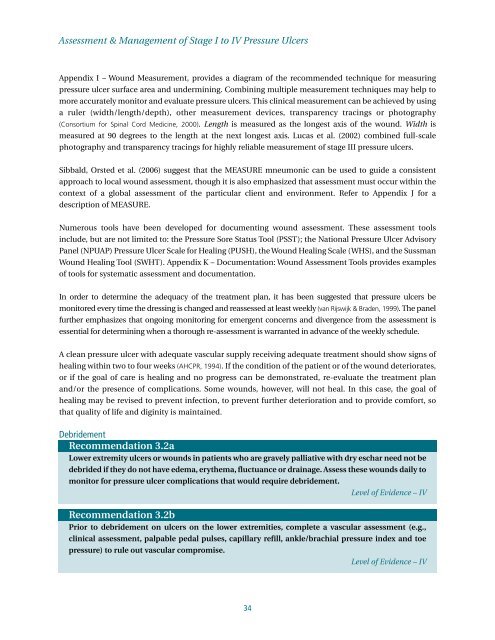RNAO BPG Pressure Ulcers Stage I to IV - Faculty of Health ...
RNAO BPG Pressure Ulcers Stage I to IV - Faculty of Health ...
RNAO BPG Pressure Ulcers Stage I to IV - Faculty of Health ...
You also want an ePaper? Increase the reach of your titles
YUMPU automatically turns print PDFs into web optimized ePapers that Google loves.
Assessment & Management <strong>of</strong> <strong>Stage</strong> I <strong>to</strong> <strong>IV</strong> <strong>Pressure</strong> <strong>Ulcers</strong>Appendix I – Wound Measurement, provides a diagram <strong>of</strong> the recommended technique for measuringpressure ulcer surface area and undermining. Combining multiple measurement techniques may help <strong>to</strong>more accurately moni<strong>to</strong>r and evaluate pressure ulcers. This clinical measurement can be achieved by usinga ruler (width/length/depth), other measurement devices, transparency tracings or pho<strong>to</strong>graphy(Consortium for Spinal Cord Medicine, 2000). Length is measured as the longest axis <strong>of</strong> the wound. Width ismeasured at 90 degrees <strong>to</strong> the length at the next longest axis. Lucas et al. (2002) combined full-scalepho<strong>to</strong>graphy and transparency tracings for highly reliable measurement <strong>of</strong> stage III pressure ulcers.Sibbald, Orsted et al. (2006) suggest that the MEASURE mneumonic can be used <strong>to</strong> guide a consistentapproach <strong>to</strong> local wound assessment, though it is also emphasized that assessment must occur within thecontext <strong>of</strong> a global assessment <strong>of</strong> the particular client and environment. Refer <strong>to</strong> Appendix J for adescription <strong>of</strong> MEASURE.Numerous <strong>to</strong>ols have been developed for documenting wound assessment. These assessment <strong>to</strong>olsinclude, but are not limited <strong>to</strong>: the <strong>Pressure</strong> Sore Status Tool (PSST); the National <strong>Pressure</strong> Ulcer AdvisoryPanel (NPUAP) <strong>Pressure</strong> Ulcer Scale for Healing (PUSH), the Wound Healing Scale (WHS), and the SussmanWound Healing Tool (SWHT). Appendix K – Documentation: Wound Assessment Tools provides examples<strong>of</strong> <strong>to</strong>ols for systematic assessment and documentation.In order <strong>to</strong> determine the adequacy <strong>of</strong> the treatment plan, it has been suggested that pressure ulcers bemoni<strong>to</strong>red every time the dressing is changed and reassessed at least weekly (van Rijswijk & Braden, 1999). The panelfurther emphasizes that ongoing moni<strong>to</strong>ring for emergent concerns and divergence from the assessment isessential for determining when a thorough re-assessment is warranted in advance <strong>of</strong> the weekly schedule.A clean pressure ulcer with adequate vascular supply receiving adequate treatment should show signs <strong>of</strong>healing within two <strong>to</strong> four weeks (AHCPR, 1994). If the condition <strong>of</strong> the patient or <strong>of</strong> the wound deteriorates,or if the goal <strong>of</strong> care is healing and no progress can be demonstrated, re-evaluate the treatment planand/or the presence <strong>of</strong> complications. Some wounds, however, will not heal. In this case, the goal <strong>of</strong>healing may be revised <strong>to</strong> prevent infection, <strong>to</strong> prevent further deterioration and <strong>to</strong> provide comfort, sothat quality <strong>of</strong> life and diginity is maintained.DebridementRecommendation 3.2aLower extremity ulcers or wounds in patients who are gravely palliative with dry eschar need not bedebrided if they do not have edema, erythema, fluctuance or drainage. Assess these wounds daily <strong>to</strong>moni<strong>to</strong>r for pressure ulcer complications that would require debridement.Level <strong>of</strong> Evidence – <strong>IV</strong>Recommendation 3.2bPrior <strong>to</strong> debridement on ulcers on the lower extremities, complete a vascular assessment (e.g.,clinical assessment, palpable pedal pulses, capillary refill, ankle/brachial pressure index and <strong>to</strong>epressure) <strong>to</strong> rule out vascular compromise.Level <strong>of</strong> Evidence – <strong>IV</strong>34
















